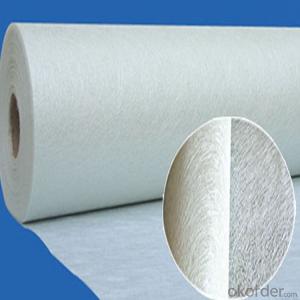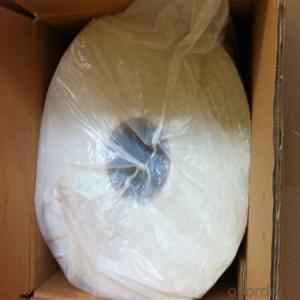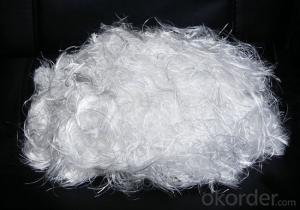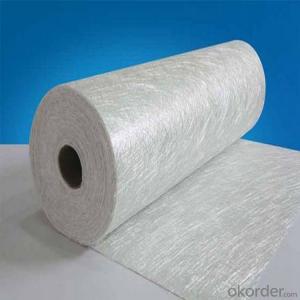Chopped Strand Mat E-glass & C-glass Fiberglass
- Loading Port:
- China main port
- Payment Terms:
- TT OR LC
- Min Order Qty:
- 1 kg
- Supply Capability:
- 5000 kg/month
OKorder Service Pledge
OKorder Financial Service
You Might Also Like
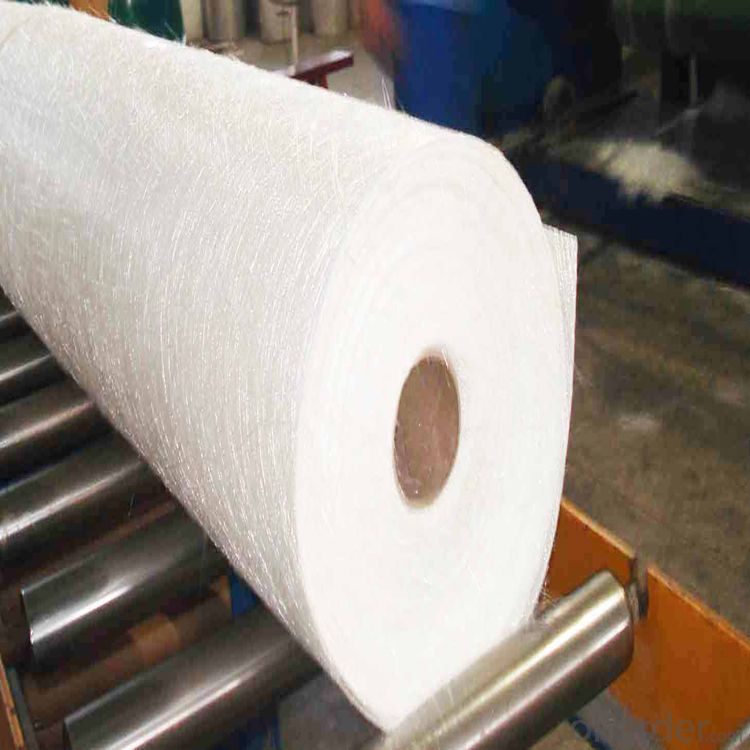
Product Description:
Chopped strand mat is made from chopped glass fibers, which are bonded with powder or emulsion binders. It can be used in hand lay-up process and continuous laminating process to produce FRP products, such as plates, lighting board, hull, bathtub, cooling towers, anti-corrosion materials, vehicles.
Good transparency for the laminates
Rapid wet out
Easy to remove air bubbles
Good dispersion and uniformity
High wet-strength retention
Good mechanical properties
Specifications:
Item | Over Density | Moisture Content | Chop Density | Polyester Yarn | Width |
(g/m2) | (%) | (g/m2) | (g/m2) | (mm) | |
EMK300 | 309.5 | ≤0.15 | 300 | 9.5 | 50-3300 |
EMK380 | 399 | 380 | 19 | ||
EMK450 | 459.5 | 450 | 9.5 | ||
EMK450 | 469 | 450 | 19 | ||
EMC0020 | 620.9 | 601.9 | 19 | ||
EMC0030 | 909.5 | 900 | 9.5 |
Special products are available according to customer’s requirement.
Product Packaging:
Each Surface Tissue is wound onto a paper tube which has an inside diameter of 76mm and the mat roll has a diameter of 330mm. The mat roll is wrapped up with plastic film,and then packed in a cardboard box or wrapped up with kraft paper. The rolls can be vertically or horizontally placed. For transportation, the rolls can be loaded into a cantainer directly or on pallets.
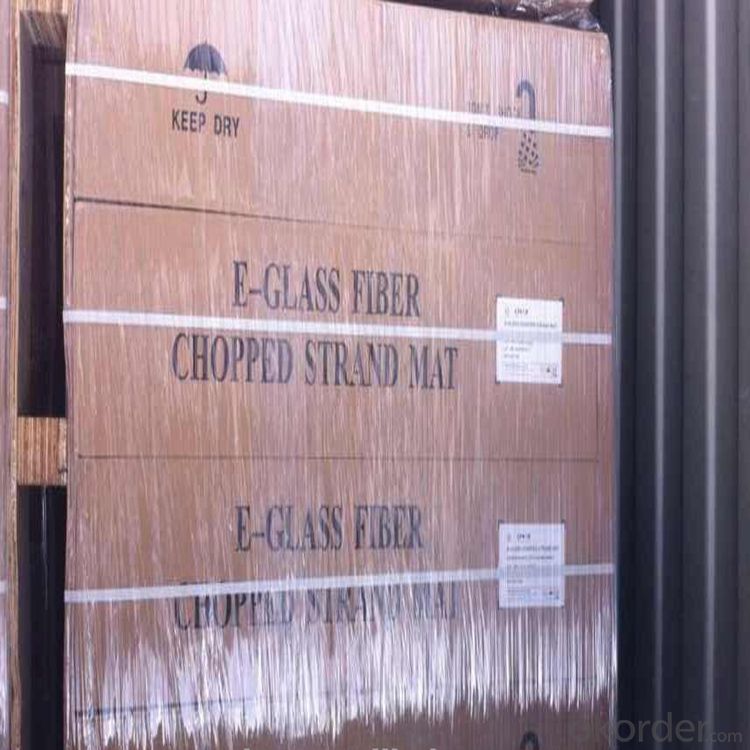
Product Storage:
Unless otherwise specified, Chopped Strand Mat should be stored in a dry, cool and rain-proof area. It is recommended that the room temperature and humidity should be always maintained at 15℃~35℃ and 50%~75% respectively.
Company Information
CNBM (China National Building Material) Group is the largest comprehensive building materials group in China that in integrate scientific research, manufacturing and logistics into one entity. The largest building materials and equipment specialists in China. Upon State Council approval, today CNBM owned more than 300 subordinate manufacturing factories and servicing companies. There are 6 fully owned public listed companies and 11 partially owned with substantial shares public listed companies. In many of these fields, CNBM is playing the leading role in the building industry in the country.

FAQ:
which kind of glass fiber sample and materials can you provide?
We can provide the glass fiber and glass fiber down stream products samples of E glass, C glass, ECR glass, High alkali glass. The products includes single end roving, assembled roving for different applications( Piping, SMC, panel, winding mill plate) , chop strand for BMC, engineering plastic (PA, PPA, PPT, POM, etc), chop strand mat (from 100gsm-900gsm) for automobile and water tank, etc, woven roving (270gsm-800gsm), surface tissue (25-50gsm), multi-axial fabric of different unit weight.
- Q:Is fiberglass chopped strand compatible with different joining techniques?
- Fiberglass chopped strand is indeed compatible with a range of joining techniques. It offers versatility as it can be connected through various methods, including adhesive bonding, mechanical fastening, and fusion welding. When adhesive bonding is used, a suitable adhesive is employed to connect the chopped strand either to another material or to join multiple chopped strand components together. Mechanical fastening, on the other hand, involves the use of screws, bolts, or rivets to establish a connection between the chopped strand and other materials. Fusion welding is yet another option, where the chopped strand components are joined by melting and fusing the fibers using heat. Thanks to its compatibility with different joining techniques, fiberglass chopped strand proves to be a versatile material suitable for a wide range of applications in industries such as automotive, construction, and aerospace.
- Q:Can fiberglass chopped strand be used in aerospace interior components?
- Yes, fiberglass chopped strand can be used in aerospace interior components. Fiberglass is a lightweight and versatile material that offers excellent strength and durability. It is commonly used in various industries, including aerospace, for its high-performance properties. In aerospace, interior components often require materials that are lightweight yet strong enough to withstand the demanding conditions of flight. Fiberglass chopped strand meets these requirements as it is lightweight and has high tensile strength. It can be used in the manufacturing of interior components such as panels, seat backs, overhead bins, and cabin partitions. Additionally, fiberglass chopped strand offers excellent fire resistance properties, which is crucial for aerospace applications. It can meet the stringent fire safety regulations and requirements set by aviation authorities. Furthermore, fiberglass chopped strand is relatively easy to process, allowing for efficient and cost-effective manufacturing processes. It can be molded into various shapes and sizes, making it suitable for complex aerospace interior designs. Overall, fiberglass chopped strand is a suitable material for aerospace interior components due to its lightweight, high strength, fire resistance, and ease of processing. Its use in the aerospace industry helps to ensure the safety, performance, and comfort of passengers and crew members during flight.
- Q:What are the thermal properties of fiberglass chopped strand?
- Due to its composition and manufacturing process, fiberglass chopped strand possesses a range of thermal properties. With its low thermal conductivity, it does not conduct heat well, making it an excellent insulator that prevents heat transfer between mediums. Moreover, fiberglass chopped strand has a high melting point of around 1000°C (1832°F), making it suitable for applications involving high temperatures. In addition, the material has a low coefficient of thermal expansion, meaning it remains stable in size and structure despite temperature changes. This property is crucial for applications that require dimensional stability. Furthermore, fiberglass chopped strand exhibits resistance to thermal shock, enabling it to withstand sudden temperature fluctuations without cracking or breaking. This reliability makes it a valuable material for applications with rapid temperature changes. In summary, the thermal properties of fiberglass chopped strand make it versatile for insulation, heat-resistant components, and other thermal applications. Its low thermal conductivity, high melting point, low coefficient of thermal expansion, and resistance to thermal shock contribute to its effectiveness and durability across various industries.
- Q:How is fiberglass chopped strand used in the defense sector?
- Fiberglass chopped strand is used in the defense sector for various applications. It is commonly used as reinforcement in composite materials, such as armor panels and ballistic protection systems. The chopped strands enhance the strength and durability of these materials, making them suitable for protecting military vehicles, aircraft, and personnel from ballistic threats, explosions, and other hazards. Additionally, fiberglass chopped strand can be used in the production of lightweight military components, such as radomes and antenna covers, due to its excellent electrical insulation properties.
- Q:What is fiberglass chopped strand?
- Fiberglass chopped strand is made up of tiny strands of fiberglass that have been cut into short lengths, typically between 1/8 inch and 2 inches. These strands are created by drawing molten glass into fine filaments and then chopping them into small pieces. The resulting chopped strand is utilized as a reinforcement material in various industries, such as automotive, construction, and marine. It is often combined with other materials, like resins or plastics, to form composite materials that possess increased strength and durability. Fiberglass chopped strand boasts exceptional mechanical properties, including high tensile strength, lightweight, and resistance to corrosion and chemicals. It is extensively employed in applications such as insulation, reinforcing concrete, pipe and tank manufacturing, and the production of fiberglass-reinforced plastics. In sum, fiberglass chopped strand plays a vital role in enhancing the performance and lifespan of a wide range of products and materials.
- Q:Can fiberglass chopped strand be used in the production of insulation foams?
- Yes, fiberglass chopped strand can be used in the production of insulation foams. Fiberglass is a commonly used material in insulation due to its excellent thermal performance and durability. Chopped strand is essentially small strands of fiberglass that are cut into shorter lengths. These chopped strands can be mixed with other materials, such as resins or foaming agents, to create insulation foams. The use of fiberglass chopped strand in insulation foams offers several benefits. First, fiberglass is a good insulator, which means it can effectively trap heat or cold and prevent it from escaping or entering a space. This property makes it ideal for use in insulation materials, where the goal is to regulate temperature and improve energy efficiency. Second, fiberglass chopped strand can enhance the structural integrity of insulation foams. By reinforcing the foam, the chopped strands can help improve its strength, durability, and resistance to deformation. This is particularly important in applications where the foam will be subject to mechanical stress or compression. Lastly, fiberglass chopped strand is relatively lightweight, making it suitable for use in lightweight insulation foams. This can be advantageous for applications where weight is a concern, such as in the automotive or aerospace industries. In conclusion, fiberglass chopped strand can be successfully used in the production of insulation foams. Its thermal insulating properties, reinforcing capabilities, and lightweight nature make it a valuable component in creating high-performance insulation materials.
- Q:Is fiberglass chopped strand suitable for applications requiring dimensional stability?
- High dimensional stability is generally not achievable with fiberglass chopped strand. Chopped strand refers to the utilization of short, randomly oriented strands of fiberglass that are bound together. This particular orientation may result in a lack of consistency and uniformity within the material, potentially causing dimensional alterations over time. In order to fulfill the requirement of dimensional stability, alternative forms of fiberglass reinforcement, such as woven or continuous strand, are typically favored. These alternatives offer a more controlled and consistent reinforcement, minimizing the possibility of dimensional changes. Furthermore, materials like carbon fiber or aramid fiber may be better suited for applications necessitating high dimensional stability due to their superior mechanical properties and stability.
- Q:Can fiberglass chopped strand be used for reinforcing ceramic matrix composites?
- No, fiberglass chopped strand cannot be used for reinforcing ceramic matrix composites. Ceramic matrix composites usually require high-temperature resistant materials for reinforcement, as they are designed to withstand extreme heat and provide excellent mechanical properties at elevated temperatures. Fiberglass, on the other hand, may not have the necessary thermal stability to withstand the high temperatures required for ceramic matrix composites. Additionally, the thermal expansion coefficients of fiberglass and ceramics are usually significantly different, which can lead to poor compatibility and potential failure of the composite. Therefore, alternative high-temperature resistant fibers, such as carbon fibers or silicon carbide fibers, are typically used for reinforcing ceramic matrix composites.
- Q:What are the typical colors available for fiberglass chopped strand?
- The typical colors available for fiberglass chopped strand vary depending on the manufacturer and the intended use of the fiberglass. However, the most common colors for fiberglass chopped strand are white, black, and grey. These colors are often used for general applications where the appearance of the fiberglass is not a primary concern. Additionally, some manufacturers may offer custom color options for specific projects or applications. It is important to consult with the manufacturer or supplier to determine the exact color options available for a specific fiberglass chopped strand product.
- Q:How does the fiber orientation of fiberglass chopped strand affect its strength?
- The fiber orientation of fiberglass chopped strand has a significant impact on its strength. Fiberglass chopped strand consists of numerous short fibers that are randomly oriented. This random orientation leads to a relatively isotropic material with strength properties that are similar in all directions. When the fibers are randomly oriented, they are able to distribute the applied load more uniformly throughout the material. This random distribution of fibers prevents the concentration of stress in a particular direction, enhancing the overall strength of the fiberglass chopped strand. In contrast, if the fibers were aligned in a specific direction, the material would become anisotropic, meaning its strength properties would vary depending on the direction of the applied load. This would result in weaker areas where the fibers are not aligned with the applied load, as the load would not be effectively distributed throughout the material. Therefore, the random fiber orientation of fiberglass chopped strand plays a crucial role in its strength, allowing it to exhibit relatively consistent strength properties in all directions and making it suitable for a wide range of applications that require strength and durability.
1. Manufacturer Overview |
|
|---|---|
| Location | |
| Year Established | |
| Annual Output Value | |
| Main Markets | |
| Company Certifications | |
2. Manufacturer Certificates |
|
|---|---|
| a) Certification Name | |
| Range | |
| Reference | |
| Validity Period | |
3. Manufacturer Capability |
|
|---|---|
| a)Trade Capacity | |
| Nearest Port | |
| Export Percentage | |
| No.of Employees in Trade Department | |
| Language Spoken: | |
| b)Factory Information | |
| Factory Size: | |
| No. of Production Lines | |
| Contract Manufacturing | |
| Product Price Range | |
Send your message to us
Chopped Strand Mat E-glass & C-glass Fiberglass
- Loading Port:
- China main port
- Payment Terms:
- TT OR LC
- Min Order Qty:
- 1 kg
- Supply Capability:
- 5000 kg/month
OKorder Service Pledge
OKorder Financial Service
Similar products
New products
Hot products
Related keywords
